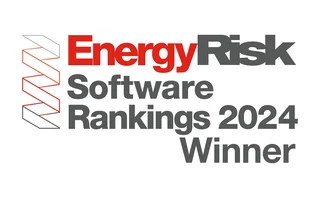
Recent turmoil in energy markets, coupled with the longer-term structural changes of the energy transition, has created a raft of new challenges for market participants
The unprecedented price volatility of 2022 highlighted the need for firms to identify their exposures and move rapidly to manage the risk. Firms unable to act quickly were far more adversely affected than those that were able to jump into action immediately.
Meanwhile, the energy transition is creating an increased need for firms to move into environmental markets and products such as green certificates, and to manage the inherent risk. The spread of renewables also brings new complexities for power producers, consumers and traders. This increased complexity means firms need robust models that can connect across many different markets to provide a holistic view of physical and financial risk. This requires vast amounts of data to be crunched in a short space of time.
“Our clients have become very focused on representing their risk holistically across their portfolios in both the physical and financial markets,” says Mark Ayzenberg, global head of sales at Beacon. “They need to be able to compute large amounts of data at a much faster rate to be able to trade competitively while also adhering to regulatory requirements.”
Beacon’s cloud-based platform enables users to model and manage risk across multiple markets using customised analytics and models. The firm was a stand-out performer in Energy Risk’s 2024 Software Rankings, an annual survey in which users of commodities software vote for their preferred vendors and systems. Beacon appeared in multiple categories in the survey, including pricing and curves, integration, cloud-based capabilities, and technology architecture and infrastructure. It was also voted a top firm for creativity and innovation.
The platform’s open-source format means users can integrate their existing systems and data, as well as build, test and deploy applications for trading and risk management. Importantly, onboarding time is weeks rather than months, Ayzenberg says.
With more organisations now entering – or re-entering – the global commodities markets in expectation of a new super-cycle and price boom, demand for these types of capabilities is rising. As these new participants focus on managing the additional risks they are taking on, Ayzenberg says he has seen an uptick in firms needing to either decommission, upgrade or integrate legacy systems.
What major issues have affected your clients over the past 18 months?

Mark Ayzenberg, Beacon Platform
Mark Ayzenberg: Price volatility in European gas and power markets has been a major challenge, with supply disruptions in Europe leading to more reliance on liquefied natural gas, boosting the US’s position as a major exporter. These changes have led to new trading opportunities for Beacon’s clients.
For example, there has been a diversification in trading styles at some of the larger utilities, exploration and production companies, and even asset managers with commodities exposure, with many launching proprietary trading desks. For this, they require more defined product sets and validated models so they can see ‘underneath the hood’. They also need the flexibility to extend into new markets such as US trading or different product types. It’s not just about simple exchange-traded futures and options – these organisations are increasingly looking at more complex derivatives products.
What impact have these developments had on clients’ technology choices?
Mark Ayzenberg: Producers, merchants and others in the physical space have been operating in a business-as-usual way to meet the energy demands of growing populations, but there has definitely been more concerted investment in two areas.
First, renewables – particularly in Europe and the US. This has been a very positive development for Beacon because our energy trading and risk management (ETRM) system has a very strong power focus. Second, more capital markets organisations – banks, hedge funds, asset managers – are re-entering the commodities space. All of these market-makers are focused on improving their tech stacks, and this often means decommissioning older systems for newer platforms like Beacon.
Our platform can also sit alongside legacy systems – which were often multimillion-dollar implementations a company might not want to completely decommission. Alternatively, firms may not want to continue investing or customising these systems. They are often ‘black-box’ solutions that require heavy professional services development from the vendor. Beacon can address such needs and, in fact, we work with a very diverse set of clients with many different – and sometimes very niche – requirements.
How does Beacon address those needs?
Mark Ayzenberg: Beacon can compete on the front end – for trade booking all the way through to back-office operations – but where we really differentiate is by ‘opening up the hood’. We expose all of our source code and provide an integrated development environment. This means our clients’ technologists, developers and financial quants can create their proprietary secret sauce on one platform that runs on cloud infrastructure.
The cloud element is important because it allows us to provide tools that help clients scale, while only paying for what they use. So a large global organisation that might have multiple settlement times in Asia, Europe and the US can run complex calculations without interrupting its other activities.
Beacon also offers application programming interface open architecture, so we are agnostic about where data is coming from, and we can connect to systems such as Ion’s OpenLink or Allegro systems, as well as connecting directly to exchanges and to central database storage solutions such as Snowflake Data Cloud.
Beacon’s partnership with Snowflake provides a centralised and securely accessible data platform allowing Snowflake to feed into Beacon Platform, augmenting and informing financial models and analytics. These models are essential for building trade analytics, which are subsequently used for pricing and risk analysis on positions. The financial objects created within this framework work seamlessly across Beacon’s ETRM applications, ensuring consistency and accuracy in trading operations.
Furthermore, our clients can create their own analytics and models externally and in different coding languages. These elements can be added to our platform and then developed further, if needed.
Beacon was ranked highly for creativity and innovation in the Energy Risk Software Rankings. How sophisticated do your users need to be?
Mark Ayzenberg: You don’t need to be a sophisticated shop to deploy Beacon. An end-user can have one developer on staff to support the platform because we’ve built in out-of-the-box functionality for trading businesses.
Given the changing trends across global commodities markets, what are the main technology challenges your clients are trying to address?
Mark Ayzenberg: Many clients are looking for vendors with a multi-cloud strategy. This means that if, for example, the Amazon Web Services server ever fails, their vendor can hook into another provider, such as Azure, and simply transfer clients to that domain.
Organisations also want platforms with an agnostic view on data and sources, plus solutions that offer them flexibility to build beyond their day-one requirements. Markets change very quickly, and organisations need flexible systems that will allow them to change too.
As companies expand into new commodities markets or re-enter the space, vendors like Beacon must be able to provide them with flexibility and the edge required to adapt and succeed.
See the full Energy Risk Software Rankings 2024 results



